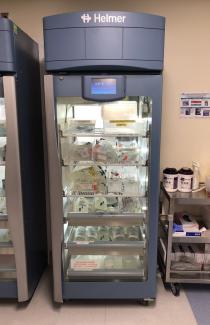As Cone Health’s flagship, The Moses H. Cone Memorial Hospital, located in Greensboro, North Carolina, is the largest and most comprehensive medical center within the five-county region. A leader in compassionate, quality care, Moses H. Cone Memorial Hospital includes a 63-acre campus with a 517-bed teaching hospital and referral center.
The hospital recently underwent a full inpatient pharmacy renovation, along with other support services, to accommodate the addition of the new Cone Health Women’s & Children’s Center at Moses Cone Hospital. The pharmacy renovations were aligned to meet or exceed the recently revised compounding standards set by the United States Pharmacopeial Convention (USP). For the most pertinent compounding standards, USP chapter <795>, <797>, and <800>, the pharmacy will be prepared for the enforcement date of December 1, 2019. Additionally, the pharmacy was renovated strategically to support streamlined workflows, introduction of new automation and technology, and integration of inventory management systems. The pharmacy is equipped to deliver exceptional patient care.
Challenges & Obstacles in the Previous Pharmacy
There were two primary challenges around cleanroom workflow in the pharmacy prior to the renovation. Both challenges involved the placement of the refrigerator serving the cleanroom. The pharmacy previously had a stand-alone refrigerator in the anteroom to store drugs needed for compounding as well as the finished batch products and non-patient specific IV bags.
If there was an order for a patient, the technician would have to leave the cleanroom to go to the anteroom to retrieve the drugs needed for compounding. This workflow was not ideal for maintaining air quality between the classified spaces.
In addition, technicians retrieving finished products were forced to cross the line differentiating the dirty and clean spaces inside of the anteroom. Placing the refrigerator fully inside the cleanroom would limit technicians from retrieving products from the main pharmacy, so that set up was not feasible.
The second challenge was around the visibility of the products in the refrigerator. With the refrigerator located inside of the anteroom, neither the cleanroom staff nor the technicians in the main pharmacy were able to see the refrigerator storing the cleanroom products on a regular basis. This increased the risk of inventory issues, products being forgotten, and forced the person loading inventory to garb before stocking the refrigerator.
Understanding Regulations Around Compounding Safety
Understanding USP <797> and state and local requirements is essential for any facility renovating their central pharmacy and cleanroom spaces. UPS <797> encourages facilities to keep only necessary items inside of the actual cleanroom. By minimizing what is stored inside the cleanroom space, it keeps the space easy to routinely clean. Moreover, personnel who are not affiliated with compounding should not be entering classified spaces, which includes the anteroom to limit any risk of contamination.
Increasing Efficiency with an Interlocking Pass-thru Refrigerator
Moses H. Cone Memorial Hospital chose an interlock pass-thru refrigerator to enhance their cleanroom workflows. The pass-thru sits between the positive pressure cleanroom and the main, non-classified pharmacy space. The interlocking pass-thru refrigerator utilizes a trim kit and 100% silicon caulk for an airtight seal. Moreover, the space is designed so that the refrigerator exhausts appropriately to preserve air quality in the cleanroom.
The location of the interlock pass-thru allows both the cleanroom personnel and the main pharmacy staff to access necessary product without any risk of air contamination.
This allows the pharmacy to supply drugs to the patient safely and efficiently while following USP <797> best practices for what to keep in and out of the clean room space.
In addition, the placement of the interlocking refrigerator makes everything inside the unit constantly visible. Cleanroom personnel can easily view and retrieve the necessary products without leaving the cleanroom which reduces the risk of air and garb contamination. On the other hand, technicians in the main pharmacy can check stock levels, par levels, and batching par levels all without entering a classified space further reducing foot traffic and risk of contamination. This workflow has also cut down on the amount of garb used and disposed.
We asked Kevin Hansen, PharmD, MS, BCPS, Assistant Director of Pharmacy at Moses H. Cone Memorial Hospital, what advice he has for other facilitates going through a cleanroom renovation. Hansen said, “Understand your regulations and state requirements! When discussing pass-thru refrigerators there are some misconceptions about their appropriateness for use in a cleanroom. Understanding the bigger picture of quality standards and movement of air will lead you in the right direction.”
The interlocking pass-thru refrigerator has reduced risk of contamination and optimized the way drugs get safely and efficiently to the patient from a fast-paced, high-volume cleanroom.
